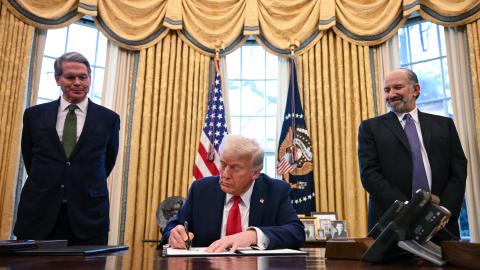This was not what the framers had in mind when the Constitution called for the president to appoint top officials, by and with the Advice and Consent of the Senate.” The purpose of involving the Senate in this effort was to allow the president to choose his team, but to prevent the distribution of government jobs to unqualified individuals. Senate concurrence in executive appointments, as Alexander Hamilton put it in Federalist No. 76, would have a powerful, though, in general, a silent operation. It would be an excellent check upon a spirit of favoritism in the President.
For a long time, the process worked fairly well, mainly because the size of the federal government was relatively small. As the government began to balloon in size, however, the process started to bog down. In 1935, there were 51 positions in cabinet agencies that required Senate confirmation. By 1960, the number was 224; today, there are 526 Senate-confirmed posts spread across a vast bureaucracy.
With this growth of government has come an increase in the time required to get individuals through the nomination gauntlet. Moreover, as the government has extended its reach, personnel choices have come to have greater policy significance. As a result, confirmation battles have become more ideologically charged and intense, assisted by new technologies -- the internet, cable news, e-mail, Twitter, and Facebook – which enable a Senator or interest group to garner attention and financial contributors by loudly opposing certain nominees.
The newly announced effort to reduce the number of management positions subject to the full Senate confirmation process will help, but such a proposal is not sufficient to solve the problem on its own. The Senate should also enshrine some reforms of the confirmation process in its own rules. Lawmakers should, for instance, commit to having the relevant Senate committee hold a confirmation hearing for all presidential nominees within two months of nomination and to an up-or-down vote on the Senate floor within one month of a positive committee vote.
The Senate, however, is unlikely to agree to this unless the White House makes some changes of its own. President Obama has not been blameless in our current state of affairs, and he should follow the new Senate suggestions with some administration-focused reforms. For starters, the White House should dramatically streamline nominee paperwork requirements. To avoid unnecessary duplication, nominees should have to fill out only one disclosure form and questionnaire, which could be completed electronically and would be made available to the relevant executive-branch vetting agencies, as well as to the relevant Senate committees. The new form should be as simple as possible, asking questions primarily about the candidate's education, relevant experience, accomplishments, and any criminal history or direct financial conflicts. In addition, the White House should commit to producing its own nominees in a timely manner, at the risk of losing access to the expedited Senate process outlined above.
The system will only get better if both sides agree to reforms that place obligations on the White House and the Senate, and also reforms that apply to both parties, regardless of who sits in the Oval Office or holds the Senate majority. Such a restoration will, of course, be no easy feat. But it can be achieved, if Congress and the president do as the framers intended when they first established the process. Only by cooperating despite institutional and political tensions will our elected officials preserve the framers' design — a design wrought in the hope that our government might be well run, and thus that our nation might be well governed.

















